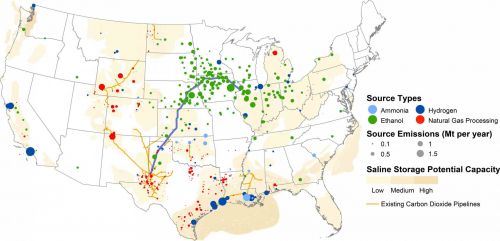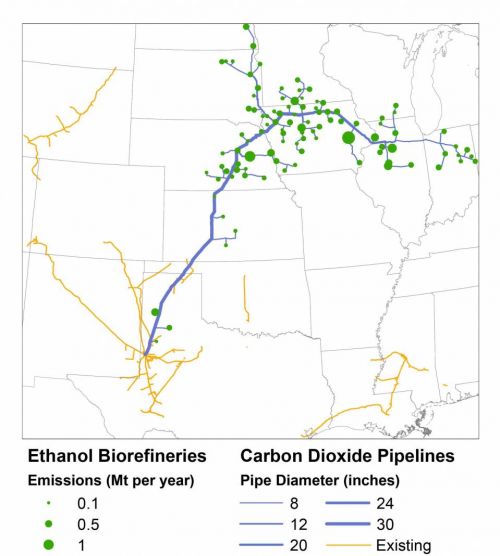本文转自《Princeton University》发表的题为“Funded by new tax credits, U.S. carbon-capture network could double global CO2 headed underground”的报道。
作者:Morgan Kelly, Princeton Environmental Institute(普林斯顿环境学院)
日期:2018.09.25
原文链接:https://www.princeton.edu/news/2018/09/25/funded-new-tax-credits-us-carbon-capture-network-could-double-global-co2-headed
With the right public infrastructure investment, the United States could as much as double the amount of carbon dioxide emissions currently captured and stored worldwide within the next six years, according to an analysis by Princeton University researchers.
根据普林斯顿大学的研究人员的分析,通过正确的公共基础设施投资,美国可以在未来六年内将目前在全球范围内捕获和储存的二氧化碳排放量增加一倍。
The authors propose in the Proceedings of the National Academy of Sciences a pipeline network that would transfer carbon dioxide waste from ethanol refineries in the American Midwest — where grains are fermented to produce the alcohol-based fuel — to oil fields in West Texas. The captured carbon would then be pumped into near-depleted oil fields through a technique known as enhanced oil recovery, where the carbon dioxide helps recover residual oil while ultimately being trapped underground.
作者在美国国家科学院院刊提出了一个管道网络,该管网将美国中西部的乙醇精炼厂的二氧化碳废物转移到德克萨斯州西部的油田,谷物被发酵生产酒精燃料。 然后通过一种称为强化采油的技术将捕获的碳泵入几乎耗尽的油田,其中二氧化碳有助于回收残余的油,同时最终被困在地下。
The researchers found that this capture-and-storage network could prevent up to 30 million metric tons of human-made carbon dioxide from entering the atmosphere each year — an amount equal to removing 6.5 million cars from the road. Currently, about 31 million metric tons of carbon dioxide annually are captured and stored worldwide.
研究人员发现,这种捕获和储存网络每年可以防止高达3000万公吨的人造二氧化碳进入大气层 - 相当于从道路上移走了650万辆汽车。 目前,全世界每年捕获和储存约3100万吨二氧化碳。

Princeton University researchers have proposed a pipeline network for the United States that would capture, transport and store underground up to 30 million metric tons of carbon dioxide emission each year — an amount equal to removing 6.5 million cars from the road. The network (thick blue line at center) would transfer carbon dioxide waste from ethanol refineries in the American Midwest (green dots) to oil fields in West Texas. Midwestern ethanol refineries, which emit 43 million metric tons of carbon dioxide annually, are currently located far from existing carbon dioxide pipelines (orange lines) and largely don’t sit atop geological formations suitable for storing CO2 (beige areas).
Image by Ryan Edwards, Princeton University
普林斯顿大学的研究人员已经为美国提出了一个管道网络,每年可以捕获,运输和储存高达3000万公吨的二氧化碳排放量 - 相当于从道路上移走650万辆汽车。 该网络(中心的粗蓝线)将二氧化碳废物从美国中西部的乙醇精炼厂(绿点)转移到德克萨斯州西部的油田。 中西部乙醇炼油厂每年排放4300万吨二氧化碳,目前远离现有的二氧化碳管道(橙色管线),并且大部分不位于适合储存二氧化碳(米色区域)的地质构造之上。
图片来自普林斯顿大学的Ryan Edwards
The authors were motivated by a tax credit passed by Congress in the 2018 Bipartisan Budget Act to encourage investment in carbon capture and storage. Their analysis showed that this large-scale capture-and-storage network would only be possible — and profitable for the companies using it — if the tax credits are coupled with low-interest government loans to fund the necessary pipeline infrastructure. If governments provided low-cost loans for only half of the pipelines, the resulting smaller-scale network would still sequester 19 million metric tons of carbon dioxide per year.
作者的动机是国会在2018年“两党预算法案”中通过的税收抵免,以鼓励对碳捕获和储存的投资。他们的分析表明,如果税收抵免与低息政府贷款相结合,为必要的管道基础设施提供资金,这种大规模的捕获和存储网络只有可能 - 并且对使用它的公司有利可图。如果政府只为一半的管道提供低成本贷款,那么由此产生的较小规模的网络仍将每年封存1900万吨二氧化碳。
“The new tax credits are the most significant policy incentivizing carbon capture, utilization and storage (CCUS) in the world today,” said first author Ryan Edwards, a AAAS Congressional Science and Engineering Fellow in Washington, D.C., who earned his Ph.D. in civil and environmental engineering from Princeton this year. Edwards worked on the analysis as a graduate student under co-author Michael Celia, director of the Princeton Environmental Institute (PEI) and the Theodora Shelton Pitney Professor of Environmental Studies and professor of civil and environmental engineering.
“新税收抵免是当今世界鼓励碳捕获,利用和储存(CCUS)的最重要政策,”第一作者,华盛顿特区AAAS国会科学与工程研究员Ryan Edwards说,他今年获得了普林斯顿大学的民用和环境工程专业的博士学位。Edwards作为研究生参与了分析,共同作者是普林斯顿环境研究所(PEI)主任Michael Celia和环境研究和土木与环境工程教授Theodora Shelton Pitney。
“This is the first time we’ve had a policy in front of us that lets us seriously consider deployment on a large scale,” Edwards said. “There’s a lot of interest in CCUS at different levels, and bipartisan support. What there hasn’t been is a plan for how this could happen and what it would look like.”
“这是我们第一次在我们面前制定政策,让我们认真考虑大规模部署,”Edwards说。 “CCUS在不同层面上引起了很大的兴趣,并得到了两党的支持。 目前还没有一个计划来计划这一切是如何发生的,它会是什么样子。”
The U.N. Intergovernmental Panel on Climate Change has identified carbon capture as a key component in reducing carbon dioxide emissions and maintaining the planet’s average temperature within 2 degrees Celsius above pre-industrial levels. To do that, it is estimated that by 2050, 5,000 to 10,000 million metric tons of carbon dioxide need to be captured and stored each year, Edwards and Celia report.
联合国政府间气候变化专门委员会已将碳捕获确定为减少二氧化碳排放和将地球平均温度维持在工业化前水平2摄氏度以内的关键组成部分。 为此,据估计,到2050年,每年需要捕获和储存5,000到10,000万公吨的二氧化碳,Edwards和Celia报道。
Nonetheless, implementation of carbon storage infrastructure has been hamstrung by a lack of policy support and large upfront costs for individual projects, Celia said.
Celia表示,尽管如此,由于缺乏政策支持和个别项目的大量前期成本,碳储存基础设施的实施受到了阻碍。
“In order for CCUS to have any chance for large-scale development, the necessary infrastructure needs to be built,” Celia said. “This includes pipelines to transport CO2 from the locations where it is captured to the locations where it can be used. Our study provides an economically feasible roadmap to build such a pipeline, which would be a critical first step for large-scale CCUS in the United States.”
“为了让CCUS有机会进行大规模开发,需要建立必要的基础设施,”Celia说。 “这包括将二氧化碳从捕获位置运输到可以使用的位置的管道。 我们的研究为建立这样一条管道提供了经济可行的路线图,这将是美国大规模CCUS的关键第一步。“
Similar large-scale infrastructures such as the Interstate Highway System and electric-power grids have been built with government financing and coordination, Edwards said.
Edwards说,类似的大型基础设施,如州际公路系统和电网,都是在政府资助和协调的基础上建成的。
“Our analysis shows that additional public support beyond the tax credits will be necessary to enable large-scale deployment in the near-term,” Edwards said. “That’s how these things are done — governments play a key role. An excellent recent example is the leadership on clean-energy infrastructure by the Texas state government that enabled the big wind-energy boom there.”
“我们的分析显示,除了税收抵免之外,还需要额外的公众支持才能在短期内实现大规模部署,” Edwards说。 “这就是这些事情的完成方式 - 政府发挥了关键作用。 最近的一个很好的例子是德克萨斯州政府对清洁能源基础设施的领导,使得那里的风能大热化。“

The authors found that the most viable pipeline network (above) would only be possible if tax credits passed by Congress in 2018 to encourage investment in carbon capture-and-storage technology are coupled with low-interest government financing of the pipeline infrastructure. After being transported to Texas, the captured carbon would be pumped into near-depleted oil fields where the carbon dioxide helps recover residual oil while ultimately being trapped underground. The proposed pipelines would help meet the increasing demand for oil while potentially limiting the drilling of new domestic oil wells in environmentally sensitive areas.
Image by Ryan Edwards, Princeton University
作者发现,只有2018年国会通过鼓励碳捕获与储存技术投资的税收抵免与管道基础设施的低息政府融资相结合,才能实现最可行的管道网络(上图)。 在被运往德克萨斯州后,被捕获的碳将被泵入几乎耗尽的油田,在那里二氧化碳有助于回收残余的油,同时最终被困在地下。 拟议的管道将有助于满足日益增长的石油需求,同时可能限制在环境敏感地区钻探新的国内油井。
图片来自普林斯顿大学的Ryan Edwards
Edwards and Celia focused on ethanol refineries because the gas they produce is more than 99 percent carbon dioxide, which makes it among the most cost-effective to capture, Edwards said. By contrast, he said, the byproduct of burning coal is only 10-15 percent carbon dioxide and the capture technology is expensive. The cost of capturing carbon dioxide from coal or gas sources ranges from $50-75 per metric ton, compared to around $20-30 per metric ton for ethanol sources.
Edwards和Celia专注于乙醇精炼厂,因为他们生产的气体含有超过99%的二氧化碳,这使其成为捕获最具成本效益的产品之一。相比之下,他说,燃煤的副产品只有10-15%的二氧化碳,捕获技术很昂贵。 从煤炭或天然气源捕获二氧化碳的成本为每公吨50-75美元,而乙醇来源每公吨约20-30美元。
At the same time, Midwestern ethanol refineries — which produce 43 million metric tons of carbon dioxide annually — are located far from existing carbon dioxide pipelines and don’t sit atop geological formations suitable for storing the gas, Edwards and Celia wrote.
Edwards和Celia写道,与此同时,Midwestern乙醇精炼厂 - 每年生产4300万吨二氧化碳 - 远离现有的二氧化碳管道,并且没有坐落在适合储存天然气的地质构造之上。
Conventional recovery from an oil well yields about 40 percent of the total oil within the rock, Edwards said. Injecting carbon dioxide into the reservoir enables recovery of more oil, typically around an additional 15 percent, he said. The carbon dioxide is separated from the oil at the surface, then the gas is returned into the ground and ultimately trapped there.
Edwards说,从油井中的常规回收产生了岩石中总油量的约40%。 他说,向油藏中注入二氧化碳可以回收更多的油,通常可以再回收15%左右。 二氧化碳在表面与油分离,然后气体返回地面并最终被困在那里。
The network Edwards and Celia propose could increase enhanced oil recovery in the United States — currently limited by a lack of affordable carbon dioxide — by 50 percent, they wrote.
他们写道,Edwards 和 Celia提出的网络建议可以提高美国的石油采收率 - 目前受到缺乏可负担的二氧化碳的限制 - 增加了50%。
“This can be a win-win for climate and domestic energy security,” Edwards said.
“这对气候和国内能源安全来说是双赢的,” Edwards说。
“Global oil demand is expected to continue past 2050, so there is a need for new oil production,” he said. “If there has to be more oil, it’s much better environmentally that we produce oil domestically from an existing field rather than drilling new wells in places such as the Arctic, or importing it from new frontiers. Being able to also sequester captured carbon makes the overall technology extremely attractive.”
“全球石油需求预计将持续到2050年,因此需要新的石油生产,”他说。 “如果必须有更多的石油,我们在现有油田生产石油,而不是在北极等地钻井,或从新的边境进口石油,这对环境要好得多。 能够隔离捕获的碳使整个技术极具吸引力。“
The proposed network would still prevent far more carbon dioxide emissions than the oil it helps extract would produce, Celia said.
Celia 说,拟议的管道网仍然可以防止二氧化碳排放量超过它帮助提炼的石油所能产生的排放量。
“The scale of the carbon problem is so large that no single technology can solve it,” Celia said. “Fossil fuels are likely to be a significant energy source for the foreseeable future. CCUS is the only currently available technology that can solve the carbon problem while still allowing fossil fuels to be used. All current projections of a low-carbon energy future include significant amounts of CCUS.”
“碳问题的规模如此之大,以至于没有一种技术可以解决它,”Celia说。 “在可预见的未来,化石燃料很可能成为重要的能源。 CCUS是目前唯一可以解决碳问题的技术,同时仍然允许使用化石燃料。 目前对低碳能源未来的所有预测都包括大量的CCUS。“
The paper, “Infrastructure to enable deployment of carbon capture, utilization, and storage in the United States,” was published Sept. 18 in the Proceedings of the National Academy of Sciences. This work was supported by the Princeton Environmental Institute (PEI) through the Carbon Mitigation Initiative, the PEI-Program in Science, Technology and Environmental Policy (PEI-STEP) Graduate Fellowship; and a 2017 Maeder Graduate Fellowship in Energy and the Environment from Princeton’s Andlinger Center for Energy and the Environment.
该论文“美国碳捕获,利用和储存部署的基础设施”于9月18日发表在“美国国家科学院院刊”上。 普林斯顿环境研究所(PEI)通过碳减排倡议,PEI-科学,技术和环境政策计划(PEI-STEP)研究生奖学金支持这项工作; 普林斯顿安德林格能源与环境中心的2017年Maeder能源与环境研究生奖学金。